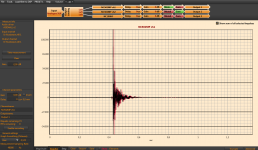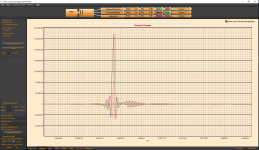Afaik, all Scarlett devices, 1st and 2nd generations, share the same cs4272. That's why I'm interested by the problems you had.
I'm interested in the nature of the timing problems too, because I have a 2i2 gen 2 that I intended to use for measurements with HFD.
How does the ADC/DAC (re)sampling in the FusionAmps fit in all of this? The FusionAmp's ADC & DAC run on a different clock than the microphone's ADC. Doesn't that introduce the same sampling uncertainty? Ideally you'd drive the Fusionamp with a digital input, digitize the mic with the FA's ADC and read it back through the USB to HFD. But I guess that that's not possible.
Afaik, all Scarlett devices, 1st and 2nd generations, share the same cs4272. That's why I'm interested by the problems you had.
They use the CS4277 as ADC and the AKM4384 as a Dac.
bo: Focusrite Scarlett 2i4 inside.
The 2i4 needs the 2 extra output channels, hence the AKM. The 2i2 doesn't and only have the CS4272.
But that's not very important. What's more interesting is the problems you had and what we should be watching for.
But that's not very important. What's more interesting is the problems you had and what we should be watching for.
I'm interested in the nature of the timing problems too, because I have a 2i2 gen 2 that I intended to use for measurements with HFD.
Two loopback measurements with the Scarlett:
https://www.diyaudio.com/forums/attachment.php?attachmentid=735582&stc=1&d=1549870611
When you do let's say 10 measurements 1 is correct. With the Focusrite ASIO driver it's more worse.
Attachments
Two loopback measurements with the Scarlett:
https://www.diyaudio.com/forums/att...tting-fusion-amp-3-step-step-meetverschil-png
When you do let's say 10 measurements 1 is correct. With the Focusrite ASIO driver it's more worse.
So basically, along your assumptions, Clarett 4Pre USB interface is also a crap? 🙁 This is eye-opening.
I discovered this when I made new measurements of my 3 way system with the Scarlett.
When I made new filtersettings I got unrealistic delay settings, like the mid was shifted fisically 30 cm forward and the tweeter to the rear.
I think the XMOS chip is the culprit, so validation of the measurement setup will be a important part in the manual.
When I made new filtersettings I got unrealistic delay settings, like the mid was shifted fisically 30 cm forward and the tweeter to the rear.
I think the XMOS chip is the culprit, so validation of the measurement setup will be a important part in the manual.
I discovered this when I made new measurements of my 3 way system with the Scarlett.
When I made new filtersettings I got unrealistic delay settings, like the mid was shifted fisically 30 cm forward and the tweeter to the rear.
I think the XMOS chip is the culprit, so validation of the measurement setup will be a important part in the manual.
Gerhard you are the right person to describe HFD workflow once and for all. I thought I could do it but now when there is uncertainity even inside of usual USB interfaces I am finally confused.
Don't be confused! These are errors which can occur in measuring for speakerfilter design. You need spot on timing in your measurements that's also the reason the UMIK is useless for this.
But now the main question is how to derivate between 'good' and 'bad' USB soundcards? There are many of them on the market. I was using E-MU 0404 USB interface until now despite its ancient drivers (interestingly, it works most stable on newest Win 10 - maybe that E-MU has soul and it is affraid to be replaced) I did not even tested that new Focusrite, I need to test it today in order to see...
With the Focusrite ASIO driver it's more worse.
It kind of points towards a driver problem. Focusrite actually has an FAQ page discouraging the use of Asio4all btw. Focusrite drivers sure are finicky.
Just to be clear (I haven't used HFD yet 😱), it's a simple loopback with a cable from output to input ? Can it be done without having a plate amp connected ?
Actually the results are far far worse with the Focusrite driver, it is designed for very low latency (recording), not accuracy (measurement).
You can test this without a amp connected, output to input on the soundcard.
You can test this without a amp connected, output to input on the soundcard.
I think i made the right choice using REW with the UMIK then xD
And also good I did not include any of the HFD measurment related steps in the guide. I will leave that up to you ds23man! 🙂
NP: Juhazi!
And also good I did not include any of the HFD measurment related steps in the guide. I will leave that up to you ds23man! 🙂
NP: Juhazi!
Actually the results are far far worse with the Focusrite driver, it is designed for very low latency (recording), not accuracy (measurement).
You can test this without a amp connected, output to input on the soundcard.
Any chance you can share the model of Behringer you have proved works well?
I bought the 2i2 just to do speaker testing with HFD and am pretty disappointed that it will introduce random timing errors.
- Home
- Amplifiers
- Class D
- Setting up a Fusion Amp 3-way Step-by-Step


